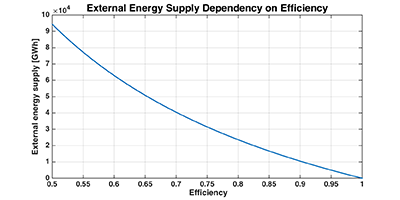Examples
Here are some examples of potential applications of the data set.
Contents
Calculation of Deficits and Surpluses
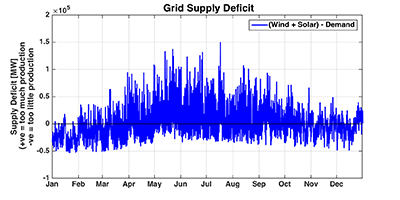
The data set's supply deficit across the year. The supply surplus (represented by positive values) is most pronounced in the summer when solar panel power production is at a peak.
Energy Storage
One possible solution to mitigate the supply deficit and supply surplus can be given by using an electricity storage technology. Since power cannot be stored, it is first necessary to convert the units from power to energy. For the following investigation the conversion from Mega Watt to Giga Watt Hour will be used: GWh = MW × 0.25h × 10-3. The key idea is that in times of surplus, the storage could be charged and therefore increase the total demand for electricity on the grid. If the charged amount of the storage is equal to the surplus of the grid, a balance between production and demand will be reached. In times of deficit, the storage can compensate for the lack of available electricity by discharging and maintaining the stability of the grid.
Ideal case: 100% Efficiency
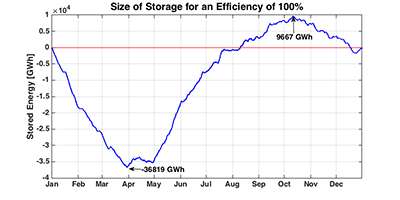
The size of the energy storage for an efficiency of 100% across the year 2025. A total of 36816 GWh + 9667 GWh = 46486 GWh needs to be stored to mitigate the fluctuations.
Realistic case: <100% Efficiency
The finding for the ideal case does not represent a realistic scenario, since there is no device which achieves an efficiency of 100%. Pumped Storage Stations (such as the Cruchanan Station) achieve an roundtrip efficiency up to 80%.[2] Assuming, the efficiency of 80% is taken into account for the process of discharging (in times of a deficit), a larger amount of energy needs to be stored to fulfil the energy deficit of the grid in each moment. The equation input(x) = deficit(x)/0.8 represents the input amount. For the charging process (in times of a surplus) an efficiency of 100% is assumed.
In case of an 80% efficiency there is an energy deficit of 23584 GWh at the end of the year. This is due to the energy losses during the charging process and therefore the annual average of production no longer meets the annual demand. The balance between production and demand is broken.
By increasing the renewable energy production by an amount of 7.22%, the balance can be restored. In this case the storage needs to have an amount of 43453 GWh stored at the beginning of the year to compensate the deficit and an additional 9372 GWh to avoid any surplus in the grid. Because of this a total storage size of 52825 GWh is needed to compensate all fluctuations across the year 2025 with an storage technology of 80% efficiency.
-
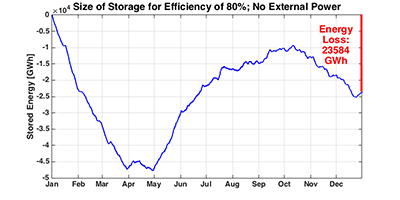
Total energy loss of 23584 GWh due to a storage technology efficiency rate of 80% across the year 2025. The annual average production does not meet the annual demand anymore.
-
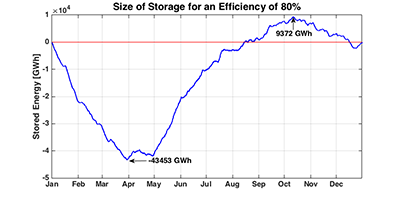
The size of the energy storage for an efficiency of 80% across the year 2025. Renewables energy production increased by 7.22% to compensate the efficiency loss of 23584 GWh. A total of 43453GWh + 9372 GWh = 52825 GWh needs to be stored.
External Energy Supply
Many different storage technologies are available and each of them could be a possible solution to guarantee a balance between power production and electricity demand at any moment. An investigation of the needed external power supply in dependency of the efficiency rate of the storage technology has been performed.
Footnotes
- D.J.C. MacKay. Sustainable Energy - Without the Hot Air. UIT, 2009. ISBN: 9780954452933. Also available for free online.
- H. Ibrahim, A. Ilinca, J. Perron. Energy storage systems—Characteristics and comparisons Renewable and Sustainable Energy Reviews, Volume 12, Issue 5, June 2008, Pages 1221–1250, ISSN 1364-0321, DOI: 10.1016/j.rser.2007.01.023.

